Endangered: Saving Manila’s remaining heritage structures comes with roadblocks
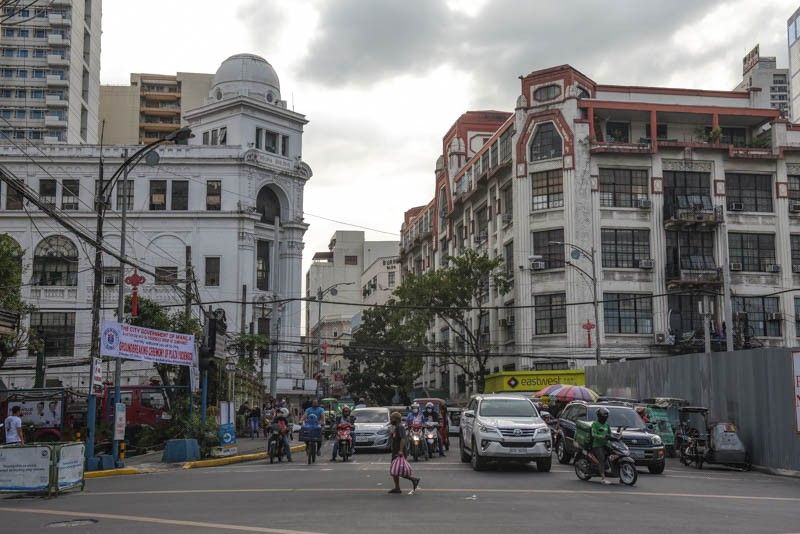
Grief overcame 35-year-old dentist Levi Azarcon when he heard about the demolition of the old Sta Cruz Building.
“We felt as if a part of us died,” Azarcon said.
Located at the entrance of the “Queen of Manila streets,” Escolta, the Sta Cruz building housed Azarcon’s clinic for four years. He and his associate dentists and staff had established a network of friends during their stay at the dental clinic. People from different walks of life — antique dealers, snack peddlers, seafarers, executives, clergy and government officials — visited the clinic.
“That edifice withstood the test of time and was a silent witness to the countless events that shaped Manila and our nation,” Azarcon recalled.
Back in 1948, the commercial building used to be called the “Watch Center of Downtown Manila.” It housed stores selling watches from luxury Rolexes to more affordable Seikos. It was also visited for its famous lottery retailer shop called Lucky Manuel Uy and the popular eatery Panciteria National.
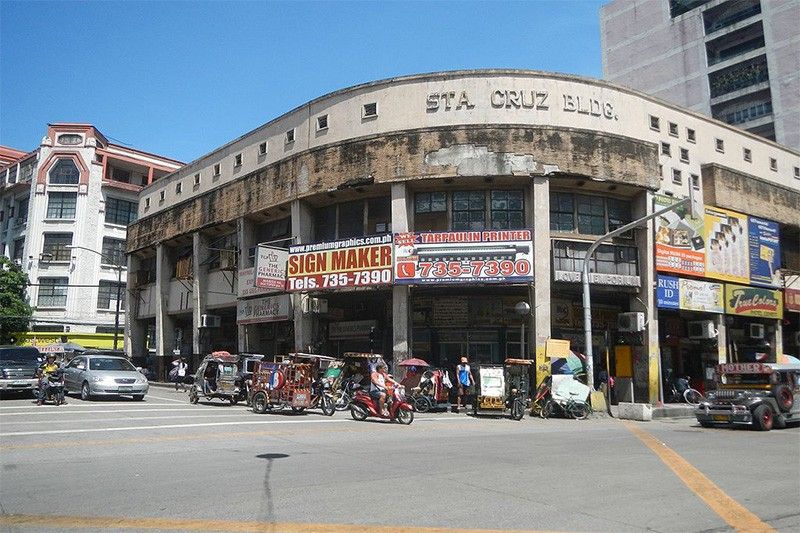
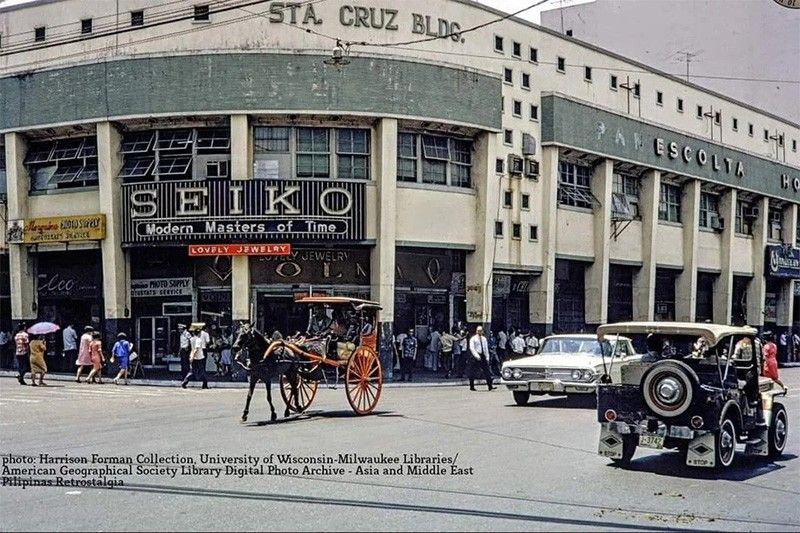
There is talk that the post-war structure would be replaced by a high-rise condominium. But for Azarcon, the building is irreplaceable.
“It was another devastating loss not only to our heritage but also to ordinary, everyday people whose lives were anchored to Sta. Cruz Building,” he said.
The former tenant is just one of the many mourners of the bulldozed building.
In late July 2021, members of heritage advocacy Facebook groups Advocates for Heritage Preservation, Conservation Advocates of the Philippines, Heritage Ready PH and Manila Nostalgia were abuzz after finding out that the majority of their treasured structure is now a pile of rubble.
On social media, they lamented that the demolition was done surreptitiously amid the COVID-19 pandemic.
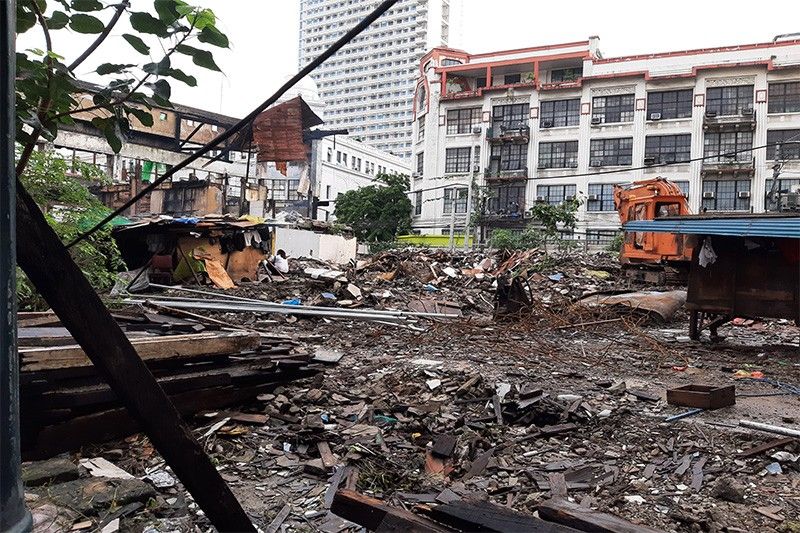
The fate of Sta. Cruz Building
Sta. Cruz building is not an official heritage structure, but it is presumed to be an Important Cultural Property under the law.
Republic Act 1066 or the “National Cultural Heritage Act of 2009,” says ICP “shall refer to a cultural property having exceptional cultural, artistic and historical significance to the Philippines, as shall be determined by the National Museum and/or National Historical Institute.”
Section 5 (f) of the law states that structures dating at least 50 years are considered ICP and therefore protected by the act.
However, the law states that “the property owner may petition the appropriate cultural agency to remove the presumption of important cultural property which shall not be unreasonably withheld.”
Timeline of the Sta. Cruz Building demolition
April 2019: Ruin
On April 4, 2019, Riel Diala, a member of the Escolta volunteer arm and heritage advocacy groups PAMANATAG and Renacimiento Manila, wrote to the National Historical Commission of the Philippines (NHCP) chair Rene Escalante raising alarm over the sudden demolition of Sta. Cruz Building. He brought up this similar provision of the law.
He said the presumed ICP was barricaded by galvanized iron sheets with portions dismantled despite the absence of a demolition or building permit signage. Diala claimed that the move violates the National Cultural Heritage Act of 2009 and the National Building Code.
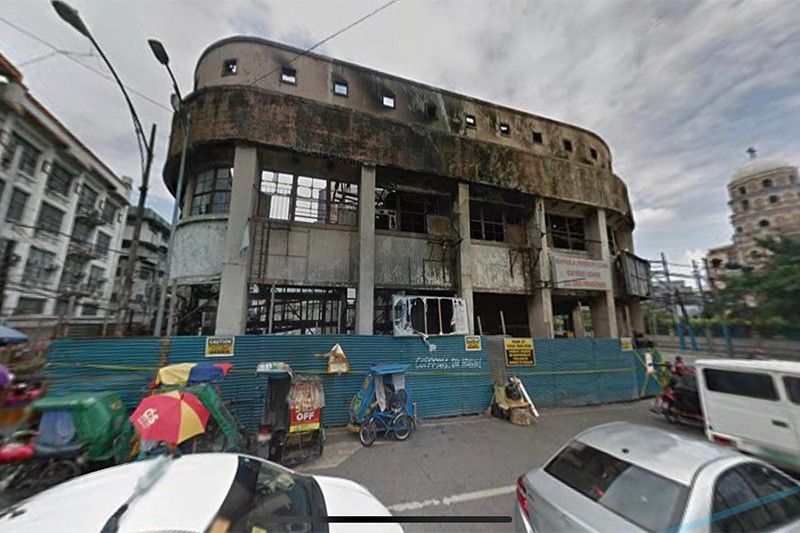
According to the 2005 revised National Building Code of the Philippines (Presidential Decree 1096), an owner or applicant must secure a building permit from the Building Official to proceed with work activity of a specific project/building/structure or portions, conforming to the code and its Implementing Rules and Regulations (IRR).
Failure to post the building permit construction information sign is considered a light violation that may incur a fine of P5,000.
The code added that the Public Works and Highways secretary may prescribe or impose fines of up to P10,000 to those who would be erecting, constructing, altering, repairing, moving, converting, installing or demolishing a private or public building or structure without building or demolition permit.
Citing the heritage law and building code, Diala and 19 concerned citizens and members of the Escolta community asked the NHCP to issue a Cease and Desist Order (CDO) against the demolition of the building. He included the office of National Museum of the Philippine (NMP) Director Jeremy Barns and then National Commission for Culture and the Arts (NCCA) Chair, National Artist Virgilio Almario in the written plea.
“There must be proper coordination of the NHCP with other cultural agencies such as the National Museum and the National Commission for Culture and the Arts regarding the matter,” Diala wrote.
May 2019: A halt
NHCP heeded their call in May 2019 and issued a CDO ordering the new owners of the building, Universal Realty Development Corporation, to stop the demolition.
In the CDO dated May 7, 2019, the NHCP chair said if the reported demolition is accurate, the owners’ action could be a violation of the National Cultural Heritage Act of 2009, which is penalized by Article III, Section 5 of the heritage law.
“All activities affecting the Sta. Cruz Building are hereby suspended upon the receipt of this order,” Escalante wrote.
The owners were asked to submit a development plan of the structure for NHCP's approval. Former Manila Mayor Joseph Estrada was also given a copy of the CDO.
June-July 2019: A stay
The Universal Realty Development Corp. through its legal counsel, Mary Frances Parreño of Palaran & Partners Law Office, asked the NHCP to lift the CDO on the demolition of Sta. Cruz Building through two letters on May 28 and June 25, 2019. However, they wrongly sent the May letter to the NCCA and not the NHCP.
The NHCP denied the request of the new owners.
“As to the danger to the public posed by the remaining facade of the building, Universal Realty Development Corporation has only Itself to blame for the same, for having commenced the demolition without complying with all the legal requirements. A demolition order from the City Government is not enough,” NHCP director Escalante wrote in a letter dated July 23, 2019.
The NHCP chair stressed that Universal Realty Development Corp. must first ask his office to remove the presumption that the structure is an ICP. The heritage law said they must file a petition, follow the verification process and submit their position paper to get an ICP delisted before a CDO would be lifted.
“The CDO will stay until they comply with the attached NHCP's Procedure on the Lifting of the Presumption of ICP,” Escalante wrote, referring to Article III Section 8 of the heritage law.
He added that Universal Realty Development Corp. cannot declare that a structure has no historical significance.
“It is the NHCP that must make such determination,” he said.
October 2019: In flames
Months after the letter exchange between the NHCP and the law firm of the new owners, news broke that fire hit Sta. Cruz Building on Oct. 26, 2019.
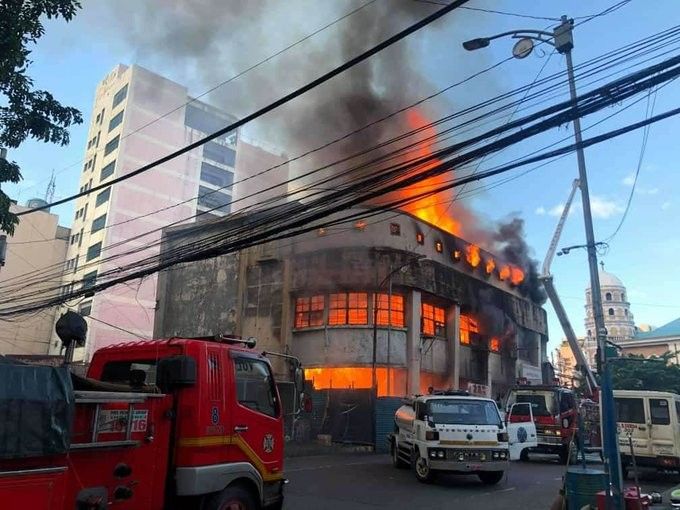
Reports noted the damage to the property was only P1,000 since the building was already abandoned. Its façade, on the other hand, was 60% burned.
The authorities also investigated the blaze for potential arson.
July 2021: Demolition
On July 29 last year, photos uploaded by heritage advocate Angelica Piguing showed that the Sta. Cruz Building was being demolished.
“Kamakailan lang ay napadaan ako at nagtataka kung bakit parang umigsi ang bakod. Napansin kong ang loob nito ay nawala na. Nagulantang ako nang makita ang pagkalaki-laking ‘Demolition Permit’ nitong buwan lang,” she wrote, referring to the Demolition Permit No. 01-2021 000505-DM dated July 12, 2021.
According to NHCP, local government units issue such demolition permits.
Philstar.com has yet to obtain the copy of the demolition order requested from Manila’s Department of Engineering and Public Works (DEPW).
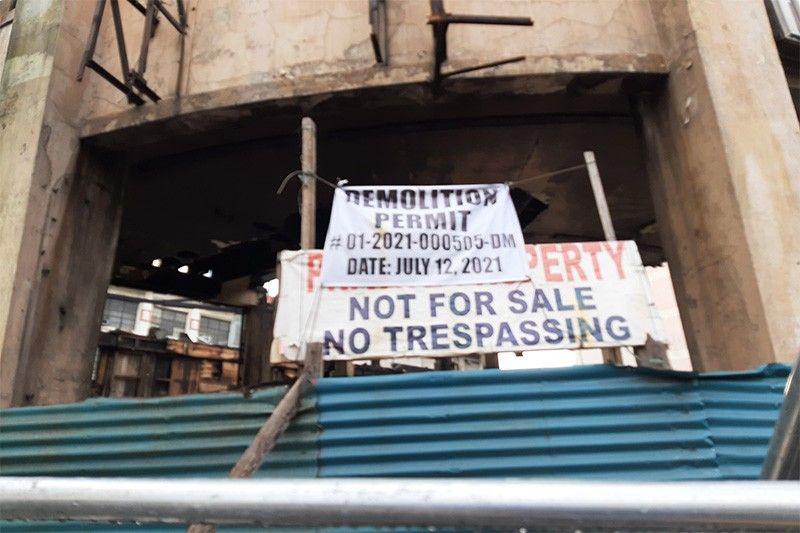
Through an FOI request, Philstar.com also learned that DEPW’s Building Officer Engineer Armando Andres called for the immediate demolition of the remaining structure of Sta. Cruz Building.
Andres cited that the July 24, 2021 earthquake that hit Metro Manila left the structure to pose “danger to the public.”
Philippine Institute of Volcanology and Seismology recorded a magnitude 6.6 quake in Calatagan, Batangas, that was felt in Manila and neighboring cities at Intensity IV on that day. This intensity is categorized as moderately strong.
In his letter to NHCP, Andres attached building inspector Engineer Guillermo Geronaga Jr’s report, vouching that Sta. Cruz Building “might possibly damage some buildings, especially [dilapidated] structures.”
“Please be informed that the remaining structure members of the Plaza Sta. Cruz building located at Escolta cor. Sta. Cruz Manila was now in critical condition which is considered now in a collapsible manner that should be demolish[ed] immediately to avoid any untoward incident,” Geronaga wrote.
August 2021: Torn down
NHCP’s Escalante approved DEPW’s request to demolish on Aug. 5, 2021.
“The NHCP is amenable to the dismantling of the facade given its existing condition such as weak foundations and building structure on the verge of collapse due to numerous cracks that pose danger to the general public,” Ecalante’s letter read.
“However, the NHCP enjoins the developer to implement the plans submitted on 30 April 2021 replicating the entire facade and arcade of the building in order to preserve the memory of the place,” it added.
The NHCP noted that the new structure should not be higher than the adjacent heritage buildings within the area. It likewise recommended the urgent installation of board-up to cover the entire structure and the provision of shoring, scaffolding, fence, canopy and safety nets for the protection of the general public.
Sta. Cruz building was completely torn down around the second week of August last year, according to a video of Arts Serrano, an occupant of First United Building.
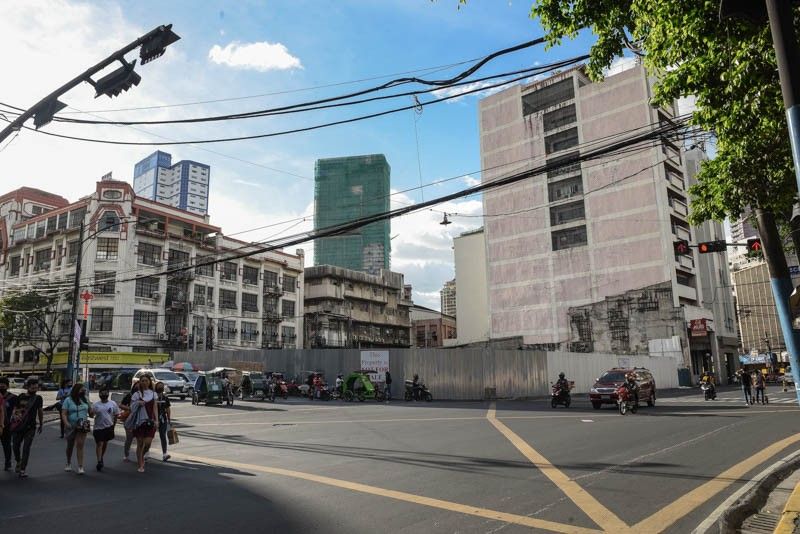
The NCCA, NMP, DEPW and Universal Realty Development Corp's lawyer have yet to respond to Philstar.com’s request for comment on the contested demolition of Sta. Cruz Building and subsequent follow-ups.
Other heritage structures of concern
Aside from Sta. Cruz Building heritage advocates are also rallying to save other ICPs feared to be demolished by new owners.
They are taking the battle cry to protect these edifices online.
IDES O’Racca Bulding
On Facebook, a page called “Save IDES O’Racca Building,” was set up to bring awareness to the history and heritage of IDES (Isidoro de Santos) O’Racca Building located in M. De Santos corner Carmen Planas (Folgueras) and Chavez Streets in Barangay 269, Zone 25, San Nicolas, Manila.
The Art Deco structure, erected in 1935, was declared Grade III Cultural Property by the NMP in 2013 and as such, protected under the heritage law.
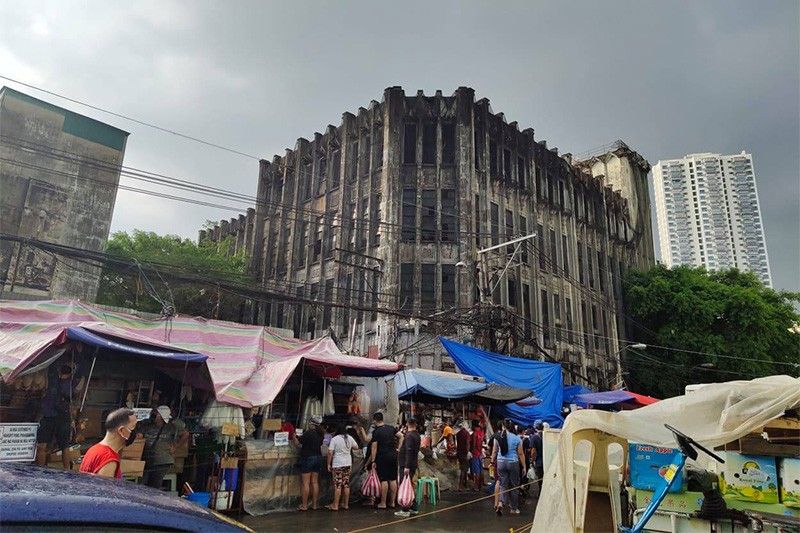
Ezekiel Roi de Santos and Stephen John Pamorada, a descendant of historical figures Don Isidro and Marcelino de Santos and resident of Barangay 269, Zone 25, respectively, wrote to NCCA and NHCP to elevate the designation of the building.
From Cultural Property-Grade III, the petitioners seek to upgrade its level to either an Important Cultural Property or National Cultural Treasure/National Historical Landmark due to its historical and architectural significance among others.
IDES O’Racca was initially a cold storage facility owned by Dr. Isidro then sold to Japanese O’Racca Confectionary. It became government property after World War II and is now owned by Anchor Land Holdings Incorporated.
In their plea, Ezekiel and Pamorada said there have been claims since 2018 that the building “will meet a wrecking ball.” They added that big companies such as its current owner “have tendencies to demolish heritage structures regardless of what the law says” under Republic Act 10066 (The Cultural Heritage Act).
“This is that year, 2021, amidst witnessing some string of demolition of heritage buildings in Manila. We refuse to accept that the Ides O’Racca Building will be the next victim of this reckless heritage massacre,” the petition read.
Despite the issues the building is facing, the petitioners said the landmark deserves recognition and restoration as it symbolizes what Don Marcelino and Dr. Isidro have left behind. It is a “symbol of their service for the Filipino People, a symbol of refuge of people from different walks of life.”
El Hogar
In 2014, two online petitions were made on Change.org to save another heritage structure, “deemed endangered” and “bound to vanish if not acted upon,” which is the El Hogar Filipino Building.
Built in 1914, the structure, occupying Juan Luna Street corner Muelle dela Industria, was the wedding gift of Spanish businessman Don Antonio Melian y Pavia, Conde de Peracamps to his wife Doña Margarita Zobel y de Ayala.
“The notable building has survived World War II and several earthquakes while boasting its Beaux-Arts architecture,” described the Department of Tourism, Culture and Arts of Manila (DTCAM).
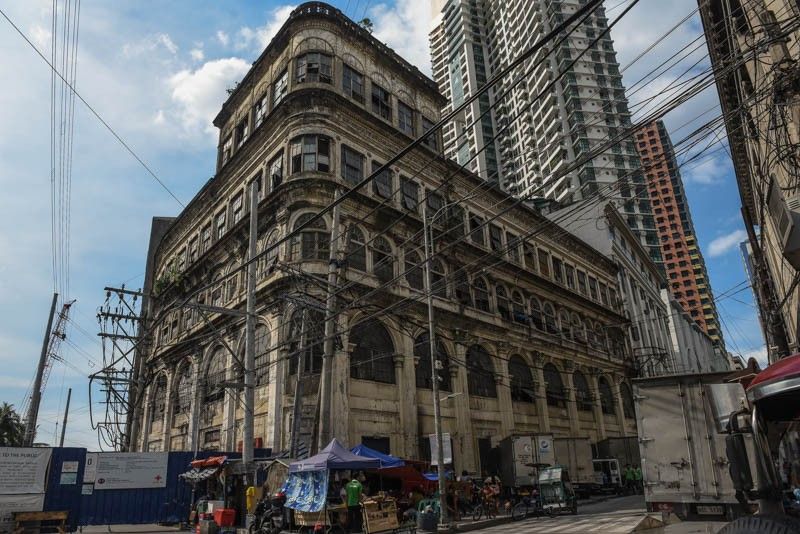
Renacimiento Manila, a group of artists and heritage advocates, has said the skyscraper used to house offices of the lending cooperative Sociedad El Hogar Filipino, as well as the Ayala y Compania now known as Ayala Corporation.
“El Hogar lasted longer than its fellow neighbors…it's a BIG waste to extinguish the little flame it has when we (the youth) have not yet seen its glory it once had,” Dana Naungayan, a supporter of El Hogar wrote.
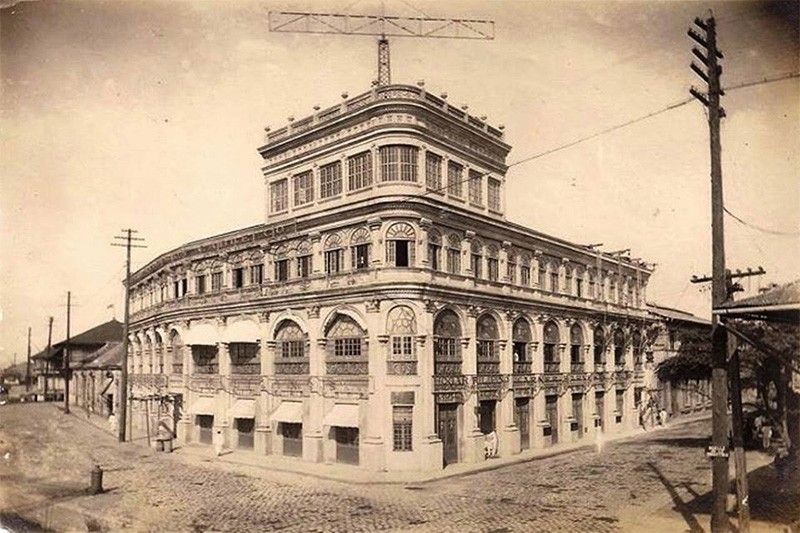
The other petitioner named Arthur Garcia shared an update dated February 2014, a report saying El Hogar tenants are asked to vacate the building.
In June 2017, the Manila government was reported to have endorsed the demolition of El Hogar. The LGU said it would still seek advice from NHCP before it issues an order, but the NHCP’s Historic Preservation Division said the Manila LGU did not do so.
Why heritage structures are not maintained
1. Policy implementation
Conservation architect and heritage advocate Manolo Noche cited that lack of policy implementation is a common hindrance when it comes to heritage conservation.
For Noche, the legal provision that 50 years old and above buildings are protected under the heritage law “is just a blanket.”
“There is a process of 50 years assumed importance to the structure and once there is that, then there’s a need for certain shall we say— approvals coming from line agencies particularly, National Museum, National Historical Institute or NHCP and the NCCA. But then again, a good number of them don’t pass through that because of again— the lack of real policy implementation,” he said in an online interview.
Noche said there are a lot of laws, but he cited some developers or property owners do not know what to do with fundamentals such as securing building or demolition permits.
“The LGU themselves are also clueless. So, that's a problem,” he added.
This was also observed by one of NHCP’s restoration architects, Luisa Valerio, who said that the LGU seems unaware of its role in heritage conservation.
“Ang nagiging problema itong si local government hindi nila alam anong gagawain nila. Ipapasa ba nila? Papayagan ba nila 'to or what? So, tumatagal,” she said, referring to the approval of construction or demolition activities involving heritage structures.
Pamorada, a former cultural heritage worker at the NCCA, the heritage advocate petitioner of IDES O’Racca Bulding, told Philstar.com that despite having the heritage law, the national government and local government are disconnected when it comes to implementing the law.
"The national level has a perspective on how to implement it. There seems to be a gap in.. not just in terms interpreting, but really implementing the law. There is a gray area because of the different interpretations. That's where the disconnect comes in," he said in English and Filipino.
Pamorada cited that there are times when the cultural agencies on a national level do not exercise their jurisdiction to the full extent leaving LGUs blindsided.
"In the long run, it's the stakeholders who [are] interested in protecting structures who will bear the brunt in this disconnect and yet the national and local agencies are not agreeing with each other towards implementing what was said in RA 10066 and other relevant laws about heritage," he added.
2. Heritage conservation roles
The NHCP is under the Office of the President, Valerio explained.
Under the RA 10066, the NHCP oversees all project developments that would affect declared historical sites, monuments and corridors, while the NMP is in charge of the pre-colonial period artifacts, significant movable and immovable cultural and natural property pertaining to collections of Fine Arts, Archeology, Anthropology, Botany, Geology, Zoology and Astronomy including its conservation aspect.
The two agencies are under the umbrella of the NCCA which is the overall policy-making and coordinating body, according to the RA 7356 or the “Law Creating the National Commission for Culture and the Arts.”
In relation to heritage conservation, Valerio said that one of the main roles of NHCP is to approve the demolition and delisting of the presumed ICPs.
On a local level, DTCAM Chief city tourism operations officer Ronald Flores said there are various internal offices involved in heritage preservation
“As to granting the permission to build or demolish any structure with a presumption of local historical/cultural significance (or any structure for that matter), the jurisdiction is with the City Engineering Office. There is also the Manila Tourism, Culture and Arts Council which if convened will take the lead in the heritage preservation,” he added.
Flores said there is a separate Sta. Ana Heritage Committee that leads the protection of Sta. Ana, declared a heritage zone by the NCCA.
3. Understanding heritage law
Since the National Cultural Heritage Act was just signed into law in March 2009, Valerio said it could be a factor as to why there is a lack of policy implementation cited by Noche and why some LGUs are unaware of their roles when it comes to heritage preservation.
Heritage structure owners also do not understand the heritage law, she said.
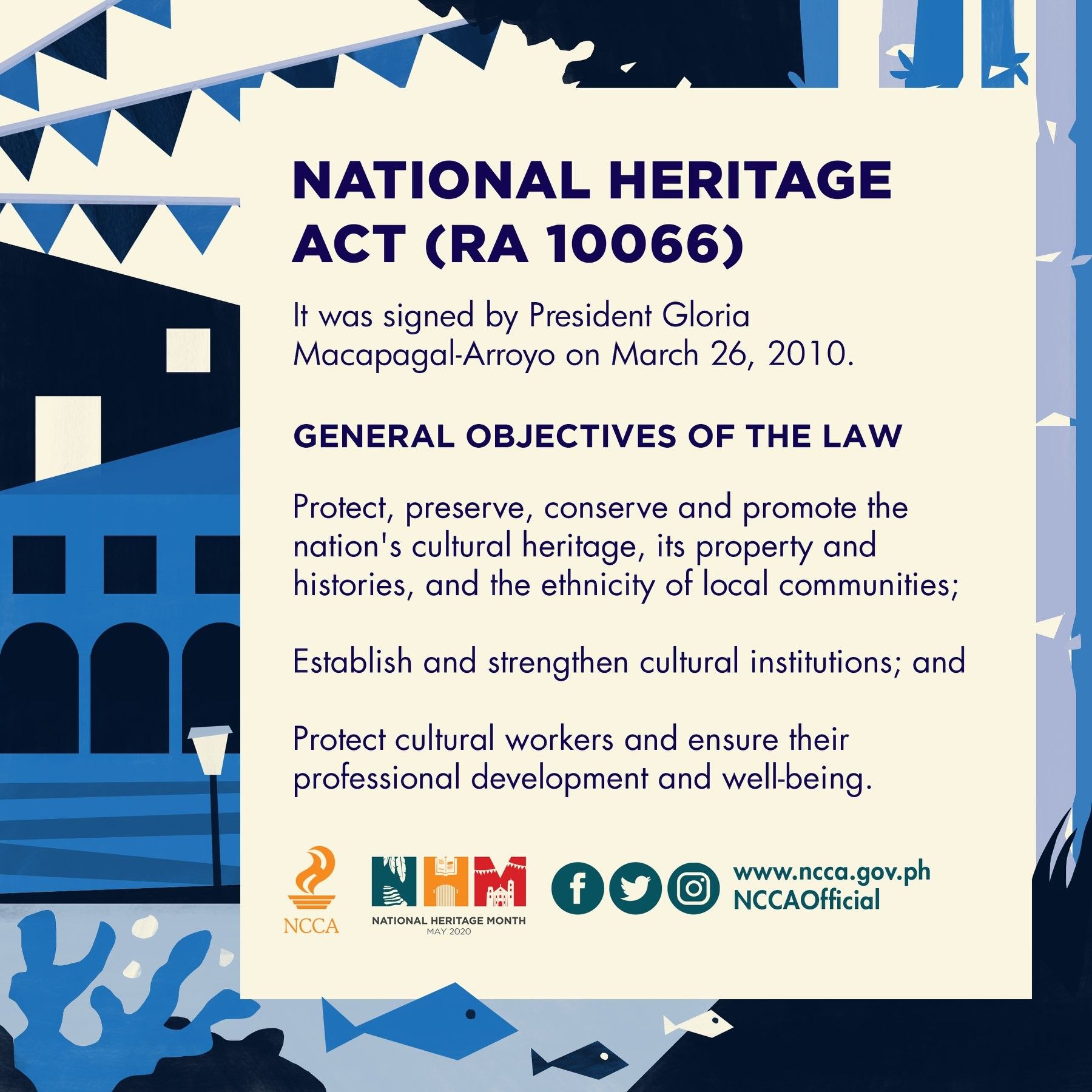
“Isang nagiging problema namin ngayon sa NHCP [‘yan], it is because…kumbaga bata pa. RA 10066 is 2009. Nag-effect lang halos 'yung development niyan. Ngayon pa lang nararamdaman 'yan. At hindi pa ganoon ka-ready ang mga locals. And even the national, they lack manpower,” the restoration architect said.
In NHCP, Valerio said there are only 12 architects and three engineers for the entire Philippines. They are also monitoring about 33 structures and other museums maintained by the agency nationwide, such as the museums in the houses of national hero Dr. Jose Rizal in Intramuros, Calamba and Dapitan.
This then makes it difficult for them to monitor all the 50-year-old structures and houses with the list growing yearly.
Owners, meanwhile, fear having their properties marked or declared a historical structure or cultural property because of the misconception that the government would take over their properties, Valerio observed.
For heritage advocate Diala, there is similarly a lack of awareness among the community or the property owners, on the significance of their heritage structures as well as the urban revival and job opportunities their properties may bring.
Despite the misconception, Valerio encouraged heritage structure owners to have their properties declared by the government to obtain additional protection.
“Ang benefit sana diyan is at least kung may mangyari, the government can provide budget. Ang problema hindi naman natin nakukuha sa lahat 'yan,” the NHCP architect said.
The NCCA said declared ICPs are entitled to the following privileges:
- Priority government funding for protection, conservation and restoration;
- Incentive for private support of conservation and restoration through the Commission's Conservation Incentive Program for national cultural treasures;
- Official heritage marker placed by the cultural agency concerned indicating that the immovable cultural property has been identified as national cultural treasures and/or national historical landmarks, sites or monuments
4. Government support
Lorraine Young-Sylianteng and Robert Sylianteng, the property managers of First United Building (FUB) in Escolta, said that they were initially hesitant to get their structure declared as a cultural property when the NHCP approached them around 2012 or 2013.
“They [NHCP] wanted to declare us pero we were saying ‘bakit kami magpapa-declare? Kung magpa-declare kami, ano’ng advantage namin?’” Lorraine told Philstar.com.
The declaration was not made at that time.
The FUB owners admitted that they did not know the heritage value of their 93-year-old building until a group of youth heritage advocates educated them about the heritage law.
Currently, the FUB, formerly known as Perez-Samanillo Building, is a registered tangible-immovable property, according to NCCA’s Philippine Registry of Cultural Property.
It was declared a heritage structure by the NHCP in 2018. The building that used to be the tallest in Manila when it was completed in 1928, was designed by Architect Andres Luna de San Pedro, the son of renowned painter Juan Luna.
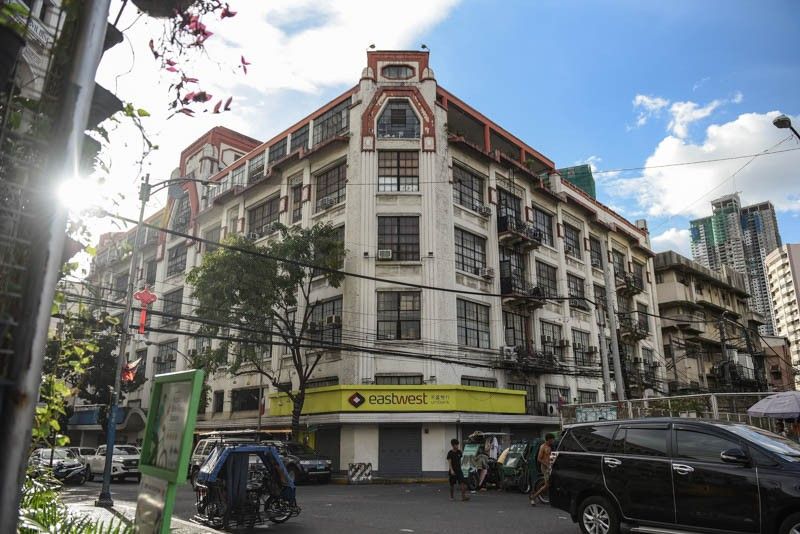
In late 2017, heritage advocates informed the Sylianteng couple that FUB is entitled to realty tax exemption from the Manila government.
Ordinance 8358 exempts certain properties, including heritage properties, from basic real property taxes. This ordinance, signed by former Manila Mayor Estrada in 2014, was principally authored by heritage supporter Manila Rep. John Marvin Nieto, who was a former councilor of Manila.
The Syliantengs subsequently wrote to the city assessor’s office and treasurer’s office to inform them about their structure. They were granted a tax holiday.
However, Lorraine said that even if the ordinance took effect in 2015, they were only allowed to avail the incentive from 2018 until 2020.
The Manila city government took back the ordinance on tax exemption last year.
For Robert, the way of taking it back was strange. The LGU said that the ordinance was “defective.”
“During the pandemic, they had found out daw that the First United Building was engaged in commercial activities,” he said and that
He lamented that the LGU should be aware that Escolta is a commercial area as it is a known historical financial district.
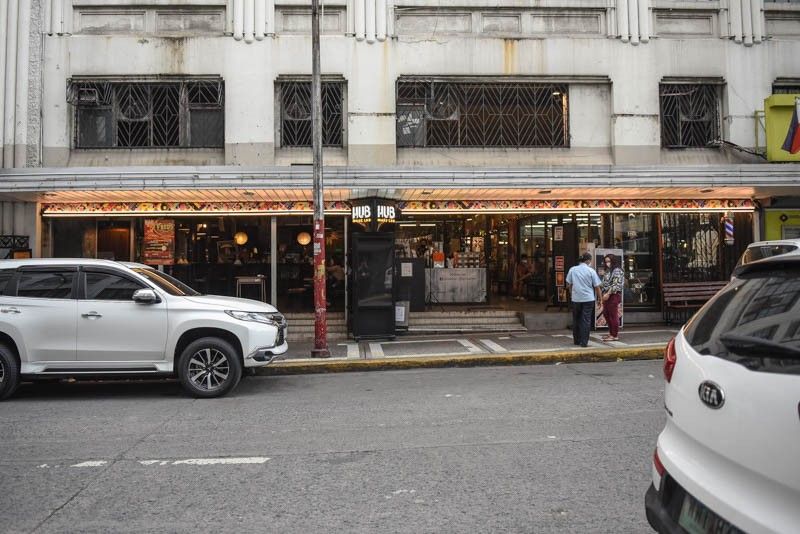
While the Syliantengs were confused with the sudden removal of Ordinance 8358, Lorraine said the tax holiday helped them.
“So, we got an exemption for 2018, 2019, 2020 and that was a lot of money for us because it was like our taxes were like P2 million plus,” Lorraine said, adding that they used the incentive to renovate their building and give back to the community.
Robert shared that among their renovation efforts include fiber-equipped communications infrastructure, building repainting, epoxy injection to repair cracks, among others.
NHCP’s Valerio also believes taxes could encourage heritage structure owners to maintain their properties well.
Lorraine said the threat to the demolition of heritage structures only comes from the owners. If they don’t care about their property, they let it go and sometimes opt to sell it.
“Kasi can you imagine you sell it especially to those Chinese from the mainland? Papatayuin nila ng high-rise. Just like what's happening in the Sta. Cruz Building. So mabebenta natin yun ng mataas na mataas na presyo,” the heritage structure owner said.
“So, we just keep the money, what do we care? What do we care what the youth of tomorrow will see? They will no longer have memories of what Manila was in the 1920s— the glory of Filipino architecture,” she added.
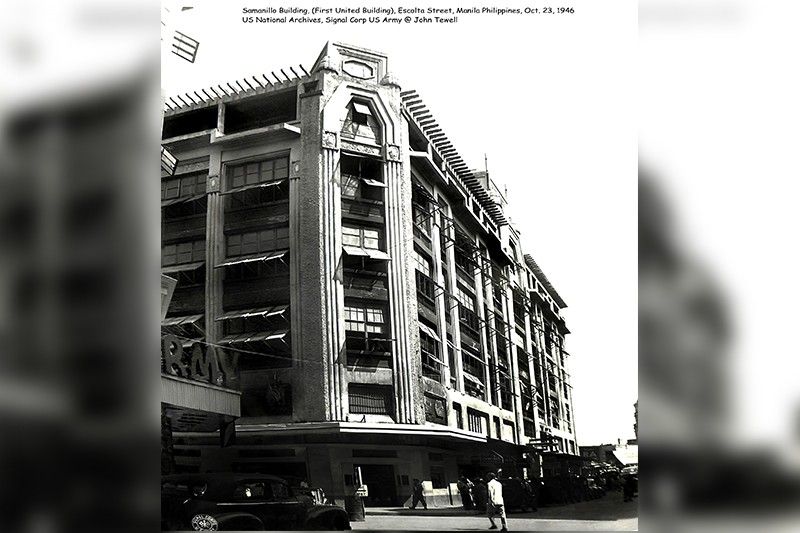
Conservation architect Noche shared another view that LGUs must also be responsible for maintaining the area where heritage structures are erected to avoid owners from abandoning their properties.
“I, as a property owner, would probably retain the property and convert that to something more profitable on my part, but I can’t do that because the community that it’s standing on has deteriorated significantly, so sino may kasalanan doon? It’s the LGU di ba?” he said.
Another architect, Arts Serrano, who houses One Zero studio in FUB, said more than superficial architectural solutions, there should be strong national and local government support for heritage districts to keep up with the modern times.
He added that the challenge is to craft concrete land use reforms “that are more mindful of protecting a locality's identity rather than blindly conforming to what the market wants.”
Speaking for stakeholders, Pamorada, who frequently writes petitions to cultural agencies to preserve heritage structures, said he had positive and negative experiences in doing so. The NCCA responded accordingly when he called for the preservation of the Old American Chamber of Commerce in Manila. It gave compromises to save the structure by maintaining its facade.
However, in recent experiences, he lamented "red tape" or additional requirements imposed by cultural agencies in terms of writing petition. Pamorada added that there are fees when applying for the verification of petitions to be filed.
As some of the agencies know that he is a former NCCA worker, he said that it might be harder for others who are not aware of the processes necessary for filing petitions to save heritage structures.
5. The dilemma between development and preservation
For the city of Manila, the DTCAM said, the main hindrance in preserving heritage structures is balancing it with progress and development.
“Manila being the capital city also bears with it the character of an urbanized and progressive local government that is the envy of others. However, we also need to protect our 450 years of rich history and culture which is our asset in our desire to reclaim our glory and be once again a premiere tourist destination,” DTCAM’s Flores said.
The tourism officer said this prompted them to craft a tourism development plan that “took advantage of the old and historic image of the capital city and harmonized it to the bustling and ever active urban lifestyle.”
The nation’s capital included eight tourism hubs in the plan in which Escolta, Binondo and San Nicolas are part of the hub with a tagline of “Sentro Ng Komersyo at Pananalapi (Center of Commerce and Finance) Cradle of Filipino Chinese Heritage and Culture”.
“In the proposal, Escolta, which used to be the key shopping center of the country, is proposed to be revived as the market for upscale brands,” Flores said.
He added that Escolta will also be part of a heritage trail that would connect Quiapo to Intramuros or Chinatown and Divisoria and vice versa.
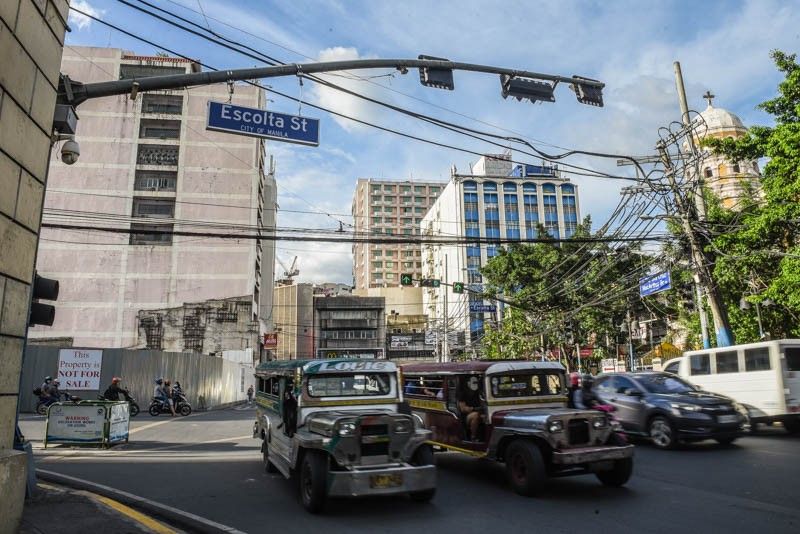
The 2020-2023 Manila Tourism and Cultural Development Plan also stated that Escolta Quay would be redeveloped and would feature a new multi-storey ferry terminal.
DTCAM said waterfront piers witnessed what transpired in Manila during the glorious years of heritage buildings near the piers such as the El Hogar, Calvo, Juan Luna, old Hong Kong and Shanghai Bank.
NHCP’s Valerio said having a vision for the future of these heritage structures is important.
She said that for Escolta’s case, even if there is a series of old buildings, it doesn’t mean that they should not allow developments.
The restoration architect underscored Manila government’s role in conducting an in-depth study on what kind of development they would allow in their jurisdiction.
She cited the case of the Walled City of Intramuros that has thematic development.
The design character is Spanish period and there is a height requirement being implemented.
According to Valerio, the key to letting high-rise developments and heritage co-exist is an apt Comprehensive Land Use Plan. The Department of Interior and Local Government said this is a document prepared by LGUs “to rationalize the allocation and proper use of land resources.”
The fruition of such plans, however, would still depend on the “political will” of the leaders in office, with leadership changing every three years at the local level, Valerio said.
“That could be done kung talagang seseryosohin 'yung paggawa ng CLUP. Kasi sa CLUP, pag naayos 'yan, alam mo pati baha maayos. Pati ang traffic maaayos. It is because na alam mo na ito lang 'yung klase ng development. [Alam mo] alin 'yung mga tatanggalin mo, alin 'yung ireretain mo at alin 'yung idedevelop mo. Anong ano niyan? Political will,” Valerio added.
“Political will talaga…Pero kung ang iisipin pa rin ng namumuno lagi e mag-korap e ‘di walang mangyayari. It is because bigay ka na lang ng bigay ng permit, kahit hindi tama. Mayroong nangyayaring ganoon, hindi natin alam,” she added.
FUB’s Robert also cited the constant leadership change as a reason why Manila could not achieve maintaining old historical structures like Rome’s Colosseum.
“In Manila, that is not happening. We have leadership who aspire for higher office when their jobs in Manila are not yet completed. That is our own version of political ningas cogon,” he lamented.
Valerio and the Sylianteng couple agree that there is a need for leaders who are allies of the heritage advocates to promote the protection of the remaining heritage structures.
Advocates like Diala, meanwhile, are hopeful that with the right people, proper initiatives and the appropriate planning and execution, the government can balance heritage preservation and developments.
“Heritage ‘eyesores’ can always be renovated and revitalized with respect to their significance. Along with these restorations come areas which can benefit the community, such as housing and even commercial space for individual businesses,” Diala said.
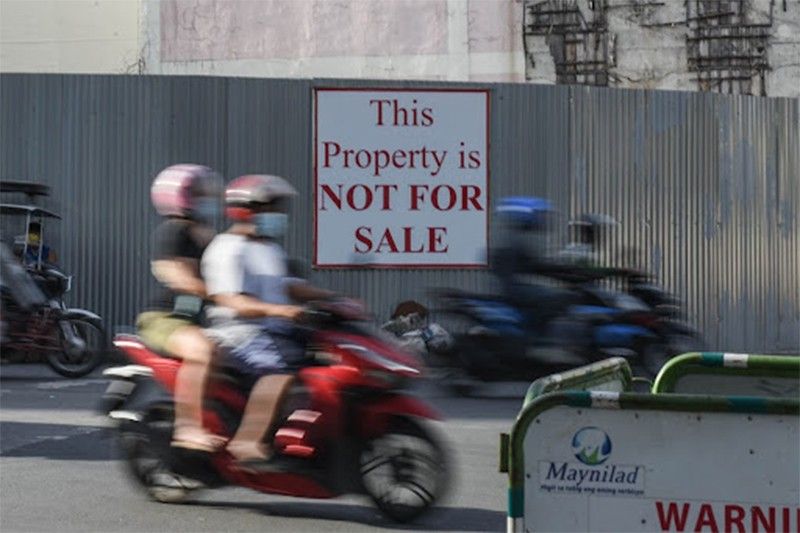
Fellow advocate, Serrano, explained the need to save heritage buildings. He said these are key pieces in our built environment that reflect different parts of our history.
He said future generations will be robbed of the opportunity to discover who they are as Filipinos through rich built heritage if these structures are torn down.
“Mostly designed by maestros in the 1900s, these are concrete examples of their aspirations for our country coming off from a colonial past. These early attempts at establishing a local identity and are thus important symbols of who we are collectively,” he said.
“That said, with cities now pivoting towards market-driven developments, much of our old towns stand as collateral damage in this race to modernity. We have to ask, who are we really building these high-rises for?” Serrano added.
There are more unsung heritage structures and historic streets in Manila that remain imperiled by modernization plans, and Binondo, Escolta, Santa Cruz and San Nicolas are not exceptions.
Diala said that if property owners construct a building that is not reminiscent of what used to stand on the site or does not adhere to the collective memory of the people, it could disrupt the “diwa ng lunan” or spirit of the place.
“This also includes people's emotions and memories that are associated with the place. A place can be affected by the people as much as how people can affect a place,” he said.
For Serrano, Escolta does not need a revival.
“It was never dead. But there is a need to put mechanisms in place to prevent the built heritage in Escolta, and other heritage districts, to be completely erased in the name of progress,” he said.
- Latest
- Trending


























